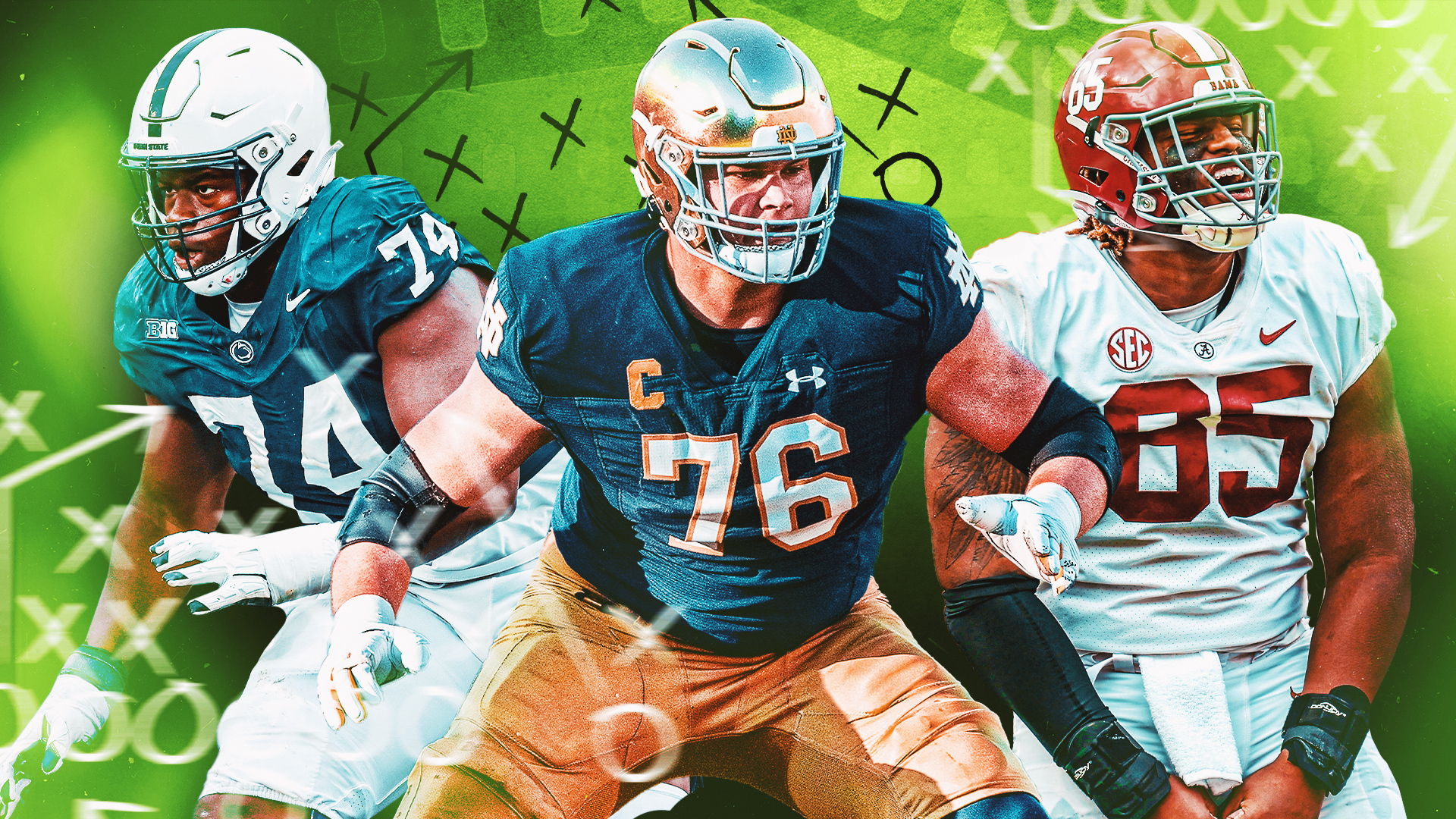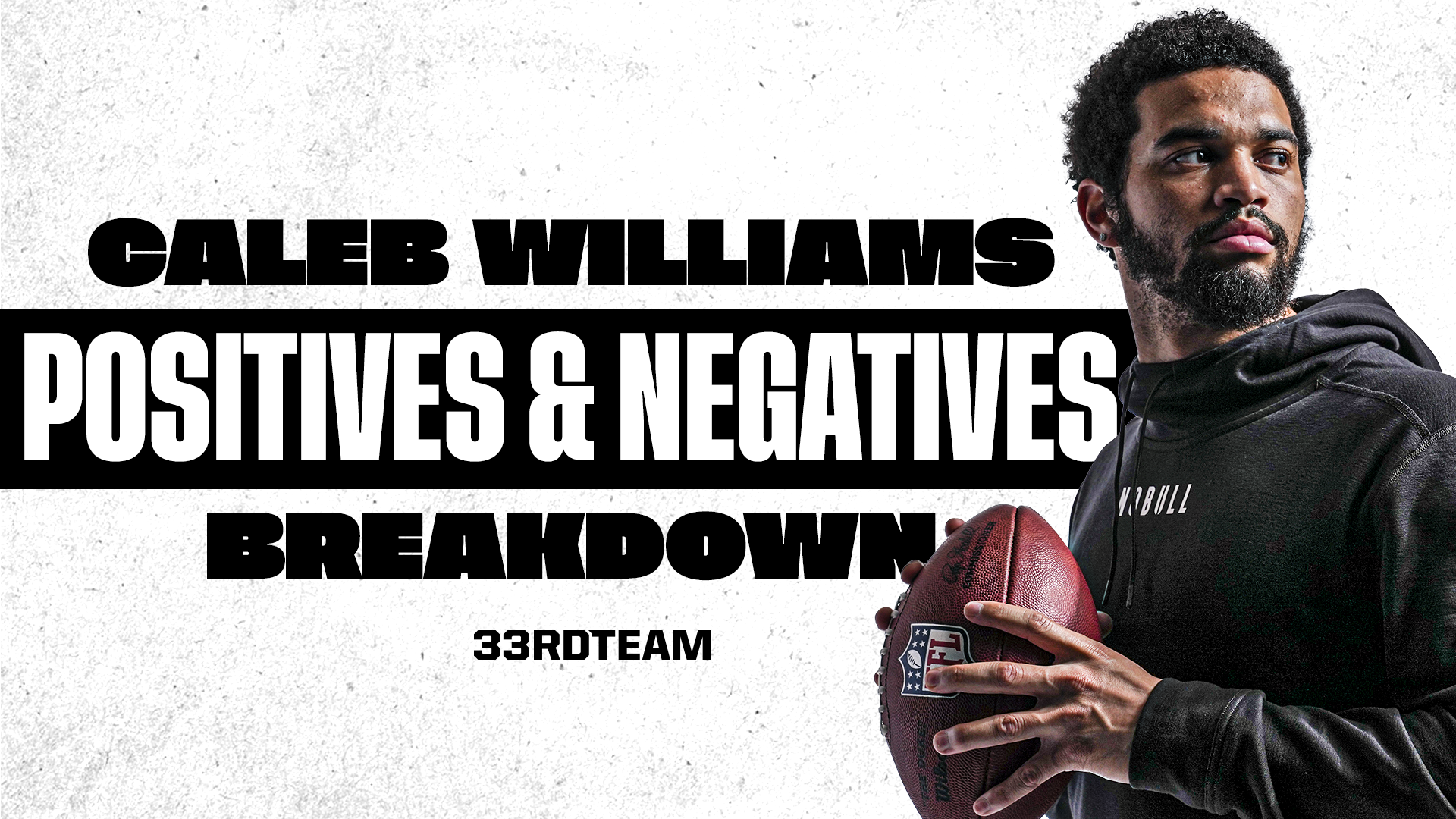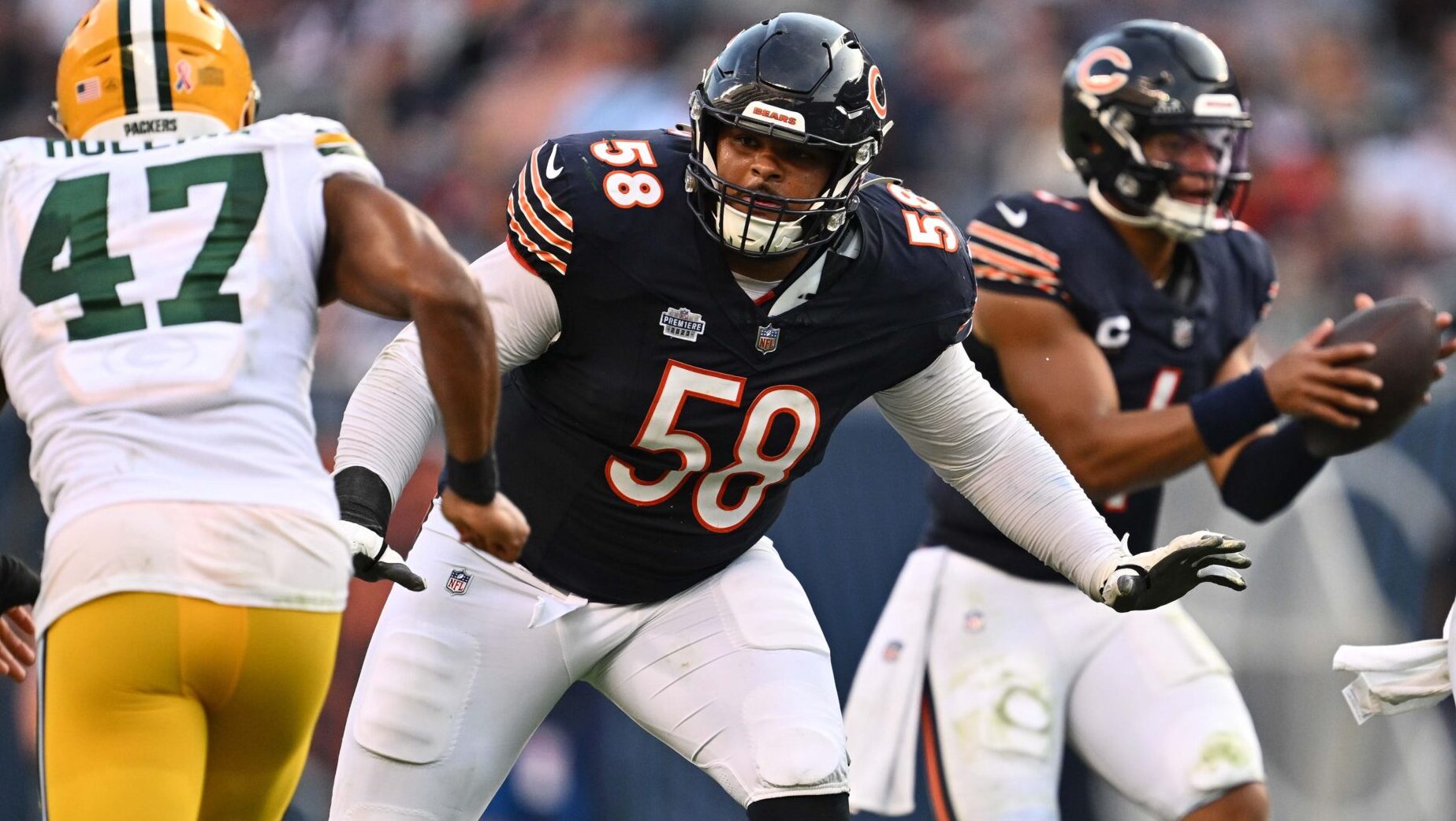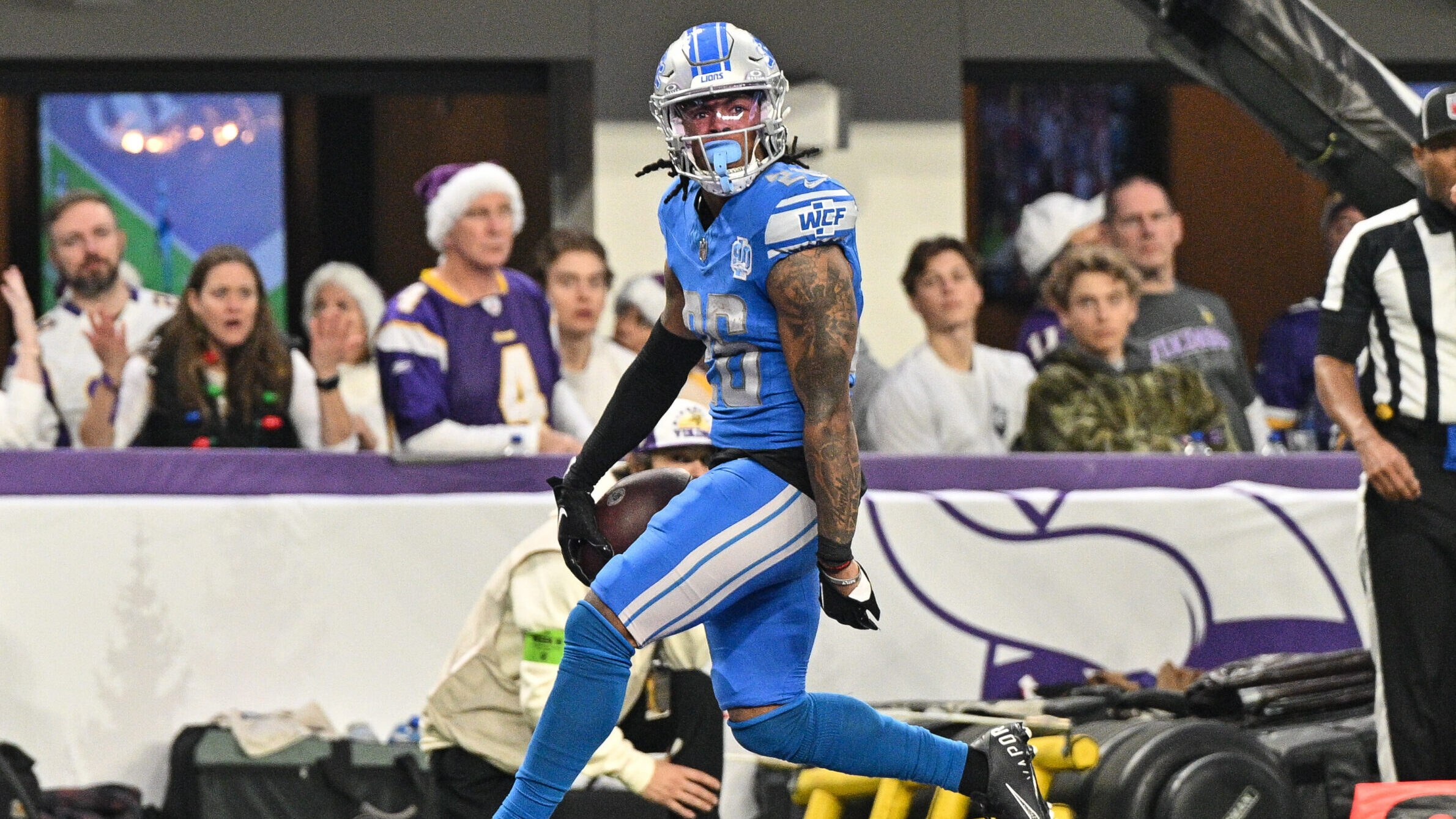Breakdowns
2/22/21
15 min read
Top 10 Interior Offensive Line Prospects for 2021 NFL Draft
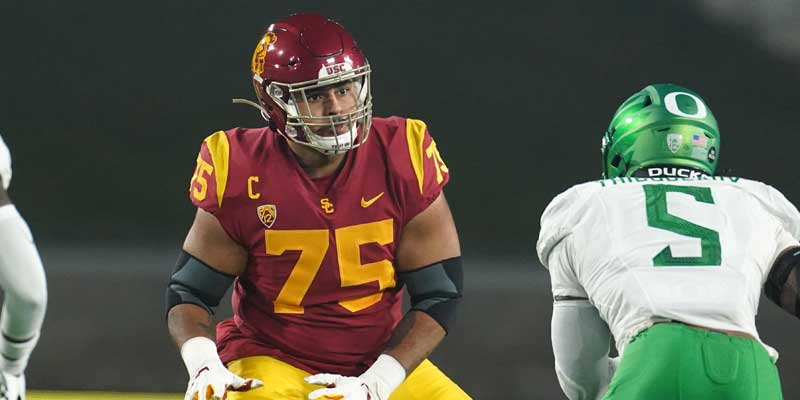

1. Alijah Vera-Tucker, USC, 6-4, 314
The best interior offensive lineman prospect in this draft, Vera-Tucker is a Week 1 starter. His versatility makes it easy for a team to move him around, although his best production will most likely come from the guard position. He played both left and right guard until the 2020 season, when he switched to LT. He has all the physical attributes you want in a lineman. He lacks pure athleticism but has great body control. Very explosive when propelling to LBs, and was even used to go after safeties. Controls the line of scrimmage better than anyone in this class. His flexibility and bend allow for him to drive and deliver low, powerful contact. Has the ability to maneuver between 1-5 techs seamlessly. He was USC's Offensive Lineman of the Year (2019) and Morris Trophy Winner (Pac-12 Lineman of the Year, 2020). A little shorter than the average LT, but he plays big and punishes DTs and LBs. He should be the first IOL off the board, most likely in the middle of the first round. Footwork needs polishing, but Vera-Tucker will be a star in the league for years to come.
2. Deonte Brown, Alabama, 6-3, 364
Maybe one of the more undervalued IOL in the draft, interviews and a further look into his off-the-field history will be crucial in determining where Brown goes. In his redshirt sophomore year (2018), Brown was suspended for the final two games of the season for a violation of team rules, but he came back and earned his starting job back in time for the 2019 season. He is a monster of a man, but being only 6-3-1/4, his weight could be a concern. At 364 pounds, he pulls and runs better than almost every other guard in this draft. His zone steps are super effective in the screen game. Brown was heavily utilized in play-action, tasked as the lead puller in charge of giving Mac Jones extra time. Has great control of his body, but needs to play more on his toes. Bends his hips too much and will be exposed if continued. Needs to get lower in pass protection and when climbing to the second level. A startable player, but needs to refine some of his technique, notably footwork. Would do very well in a bully-style run offense with lots of play action. End of first-round grade, but will most likely go somewhere early second round at great value.
3. Landon Dickerson, Alabama, 6-6, 326
The second Alabama product in our top 3, Dickerson is the best center in this draft when he plays, but staying on the field has been an issue for him as he's had three season-ending injuries. One of the top versatile linemen coming out of high school, Dickerson committed to Florida State, where he stayed for three seasons before transferring to Alabama in 2019. At 6-6, 326 pounds, he is built solid while also maintaining great speed and athleticism. A field general who demonstrates the ability to call out protections and make adjustments on the fly. Always plays to the whistle and has a natural feeling for where to be, constantly putting himself in a position to make a play. He also sees down the line pre snap very well. One of the most athletic linemen in the draft, he has the ability to transition between 1-5 techs very easily. Burst nicely to the second level with the control to engage. Needs to improve his change of direction when encountering LBs. Has a good bend in his knees, plays on his toes. A very strong player, he alters defenders’ rush pursuits. Great hip and ankle flexibility. One of the best at winning the hand battle inside. His quick zone steps allow him to wash out defenders and move to the next level in the same play. In pass protect he sits nicely while having the ability to encounter multiple rushers. Meets DTs at the line of scrimmage. Didn't pull too much, but displays the ability to move down the line. Needs to polish footwork when engaging defenders on screens. His future undoubtedly will revolve around his ability to stay healthy. A team in the market for a starting center can look to get value in taking him late in the second round or early third round with a lot to prove to teams this offseason.
4. Wyatt Davis, Ohio State, 6-4, 315
A center and tackle's best friend on double teams, anyone can be confident starting Wyatt Davis in Week 1. He is a big, strong, athletic guard who can move quite well. He exclusively plays RG. Solid base with room to grow without losing agility/speed. His grandfather is Hall of Famer Willie Davis. Davis was also a consensus All-America in 2019. He suffered multiple left knee injuries in 2020 (vs. Michigan State and Alabama), but is someone who can play in multiple schemes (inside zone is a point of strength). Gets to the second level very nicely but goes shoulder first in LBs (footwork issue). Has some problems blocking in space and needs to break down better. Makes it difficult for defenders to get hands in air, great at fighting for inside hand position. Needs to get lower, but has a great anchor in pass protection. He is slow laterally. Turns hips nicely but needs to really work on his balance, displays ankle stiffness. Has a great ability to take on a double-team block and then pick up a blitzing LB on the same play. Nice recovery, which he uses to refuse defenders the opportunity to burn him. We can expect an early- to mid-second round pick on Davis with any team being comfortable with his matchup versus almost anyone in the league.
5. Trey Smith, Tennessee, 6-6, 330
The No. 1 prospect in the class of 2017, Smith started 12 games as a freshman at LT. Seven games into 2018, doctors found blood clots in his lungs that caused him to miss the rest of the year. He came back in 2019 and moved to LG, only allowing one sack and accounting for one penalty. He has a huge frame and is very athletic. Uses size to his advantage and is a mismatch against most defenders. A very aggressive player that hates whoever lines up against him. Plays with instincts, but needs to work on decision making in terms of timing of blocks. Follows through on plays with great urgency, but needs to be more consistent in the quality of plays (seen pancaking one play and then getting burned the next). When he anchors, he is unmovable, but shows tendencies of getting too tall (shown a lot in pass pro), resulting in him getting driven back. Needs to keep head up more. Much better run blocker than he is in pass protection, but is not a one-dimensional player. Strikes first and drives defenders back as good as anybody. Smith will be a solid starting guard in the league who will benefit from coaching to harness his physical abilities. Health concerns and half a year missed are why he isn't labeled as a Day 1 pick. Not many college DTs or LBs that could matchup against him, and he is a guy opposing defenses have to gameplan for. If he can improve his footwork and stay healthy, there is no reason why he couldn't start Week 1. A solid second-round pick to a run-first/play-action team.
6. Creed Humphrey, Oklahoma, 6-4, 312
Humphrey is a solid player who has all the attributes to be a starting center in the NFL. He also benefits greatly from experience as a wrestler. His father was an All-American wrestler at Central Oklahoma, and Creed wrestled in high school (19-1 record). As a freshman at OU, he benched 400 pounds and squatted 600 pounds. Measured in at the Senior Bowl at 6-4-5/8, 312 pounds. Part of a line at OU that won the Joe Moore Award. Shorter arms (34-3/4”) but has a flexible base with room to grow. Plays with tunnel vision, but in doing so misses "football plays" at times. Loses himself in open space, poor against linebackers. Slow runner, inefficient on pulls and zone steps. Will get burned in pass pro by faster DT/LBs. Needs to seriously work on his footwork and breaking down when it comes to play at the second level. Grabs around players like a "salad tong,” needs to work on hand placement inside. Has a good build, but plays too high. Aggressive and great in the run game when he drives his feet. Meets defenders at the line of scrimmage. Has a great burst when attacking in the run game, needs to work on breakdown. Looks for work, not afraid of contact. Uses strength over technique quite often. Great at manipulating defenders with hands. Does a great job altering the pash rush, but needs to bend knees more and create a stronger base. Will be more useful on a run-first offense as run blocking is the best part of his game. Played in a system where he was mostly snapping out of shotgun, so will need to see how he adapts to under center. A team can be comfortable taking Humphrey with an early Day 2 pick due to the lack of top level talent at center in the draft.
7. Ben Cleveland, Georgia, 6-6, 354
They don't call Ben Cleveland "Big Country" for nothing. At 6-6, 354 pounds, he towers over defenses. A great build that consists of a strong upper body and sturdy base. A high school baseball star as well, he can move well for his size. Missed end of season after fracturing fibula against Missouri (2020) and has been affected by injuries before (i.e, leaving game vs. Kentucky in 2020). Really good at knowing where to be and when. In pass protection, he is often seen sliding off and picking up multiple guys. When engaged, he goes very hard, but when not has a tendency to just watch plays unfold. Very nasty player in the trenches who takes every assignment personally. He doesn’t have great speed, yet has powerful zone steps and down blocks. Burst nicely to the second level, but lacks athleticism. Needs to run lower. Doesn't change direction well when in space. Relies on strength over technique. Anchors well in pass protection, very few get by. In the run game he strikes hard and fast at the line of scrimmage. One of the biggest bodies in the draft, Cleveland's combination of size and film shows potential to be a solid starting guard in the NFL. He was suspended from school for a part of his senior year in high school, and has had a few off-the-field issues in college as well regarding social media. Injury history should also be monitored, but with the right coaching, can be very dominant. Can mold well in any scheme, and should be a solid mid-second-round pick.
8. Josh Myers, Ohio State, 6-5, 312
At 6-5, 312 pounds, Myers has everything you look for physically in an NFL center. Strong, long arms, and a solid foundation. His mom is in Dayton's Women's Basketball Hall of Fame, while his dad and brother both played for the Kentucky Wildcats. He has the ability to put on a few pounds without it affecting play, but athletically is maximized. Has good situational awareness. Great ability to know how long to engage in a double team and when to kick out to another block. Displays down the line vision. Big motor, always trying to be in the play. Can get to the second level, but does poor job of engaging. Needs to be more physical for his size. Relies a lot on his size and strength, but gets pushed back against lower and more powerful DTs. Needs to get more initial leverage, although he does a good job setting in his tracks and anchoring. Nice burst on zone steps. Great hand placement, engages really well and uses his length to his advantage in pass protection. A much stronger pass protector than run blocker. Not getting power in a gap scheme, no big malling plays. Looks lost in space. Plays mostly on his toes, not caught many times bending too far forward. Great recovery, springs back even after losing the first yard. Good college center, but nothing on tape points to him evolving into a top tier at the position in the league. Against more refined competition, he will struggle at the line of scrimmage. Doesn't display the ability to call out blocking schemes on tape. Did a lot of different things scheme-wise at OSU, which means he will adapt nicely into a pro offense, ideally a pass-heavy team. Feet are weighing him down (lack of ankle flexibility) and has little flexibility in hips. He is a solid, durable player who could go mid- to late-second round.
9. Drake Jackson, Kentucky, 6-2, 290
At 6-1-7/8 and 290, Jackson is a smaller body on film with an even smaller reach. Limited growth in terms of height, it will be important to maintain healthy playing weight. Undersized but plays bigger than he appears. He does have the ability to match up against larger defenders and succeed. Very durable, doesn't let injuries take him off the field. He separated his shoulder on the second play of the Senior Bowl game, but refused to miss a snap. Adapts to situations seamlessly as plays evolve. Makes up for lack of size with his football IQ. Great instincts identifying threats, and understands how to help extend plays. Always plays until the whistle. Very quick. Nice burst to second level. Lateral movement is one of the best from an IOL. Hip bender who lunges at defenders due to lack of size. Runs well in open space, but runs high. Not the strongest player but knows how to manipulate a defender's momentum. Has the ability to get out to farther zone blocks without missing assignment. Great at winning the hand fight inside, but gets pushed back on rushes (needs to anchor down better). Loses "low man" battles often against taller DTs and LBs. At the second level, he must be able to break down against quicker LBs to engage longer. Effective in the screen game, but relies on weight and momentum to knock back defenders, not technique. In 1,189 pass-block snaps in his collegiate career, he only surrendered 1 sack. Powerful first strike, but needs to follow it up with a powerful engagement. Does a good job meeting at the line of scrimmage. Don't be fooled by his size, Jackson can play the center position as well as anyone in college football. First-team All-SEC in 2020, he has earned his place in this draft. Best scheme would be in an OZ-heavy offense where center speed is desired. Size will most definitely be a limitation against bigger 1 and 3 techs, and he needs to learn to use his low center of gravity to his advantage. Would benefit from a full offseason to gain some strength, but is someone you can be comfortable playing. Won't be a starter right away, but could be most certainly down the road. An early third-round pick projection for this high motor, high IQ Center.
10. Trey Hill, Georgia, 6-4, 330
Following his high school QB Jake Fromm's path, the former No. 3 guard prospect in the class of 2018 originally played right guard his first year at Georgia. In the Kentucky game of 2018, he filled in at center after Lamont Gaillard went down with an injury, and in his sophomore year (2019) he switched to center full time. Has a solid build for an NFL caliber center. Good arm length, solid base, but missed the last two games of 2020 with a knee injury. A smart player who is very aware down the line. Multiple times he has shown the ability to snap after a jump for a free play. Calls out assignments and makes adjustments pre play. Plays with urgency and tries to keep involved in every play. Has an issue in thar when he loses an assignment, he just jogs around or is slow to get up. Upper body and lower body have very minimal connection. Very slow in space, but has a nice one-burst step. Second-level play is very poor, cannot engage with LBs. Ankle stiffness makes lateral movement very difficult. Severe hip bender who ends up on the ground on multiple occasions. Has strong arms and uses it to disrupt the rush paths of defenders. Cannot move with quicker defenders in space. Often driven back deep into the pocket. When he strikes first, it is powerful, but more often than not he doesn’t get the first hit in. Zone steps nice, but does not break down, so he often misses ensuing LBs. Plays strong, but is inexperienced. Pass protection is better than his run blocking, but he relies heavily on double teams to be successful on assignments. Quicker DTs and LBs will expose him. Hill will provide teams depth at the center position, and with time could prove to be startable, although he might even benefit from a switch back to guard. A young player with a size and frame to grow into, his potential is capped by lack of athleticism. Hill's success is a product of his scheme and supporting cast, but a further analysis of his tape tells a more convincing tale. He had surgery to repair injuries on both knees to end 2020, and with already a limited flexibility and bend, how he rehabs will be all the more important. A third-round pick would be fitting, but lack of top center talent may put him as high as a late second-round pick.


